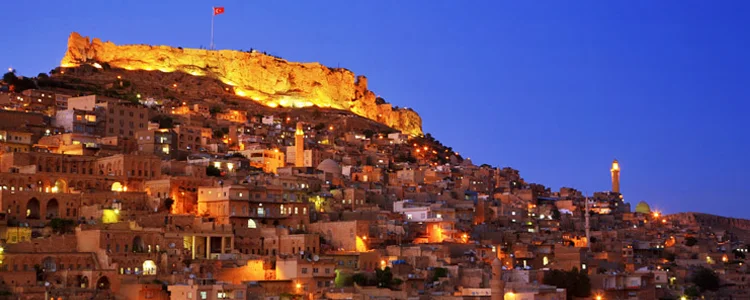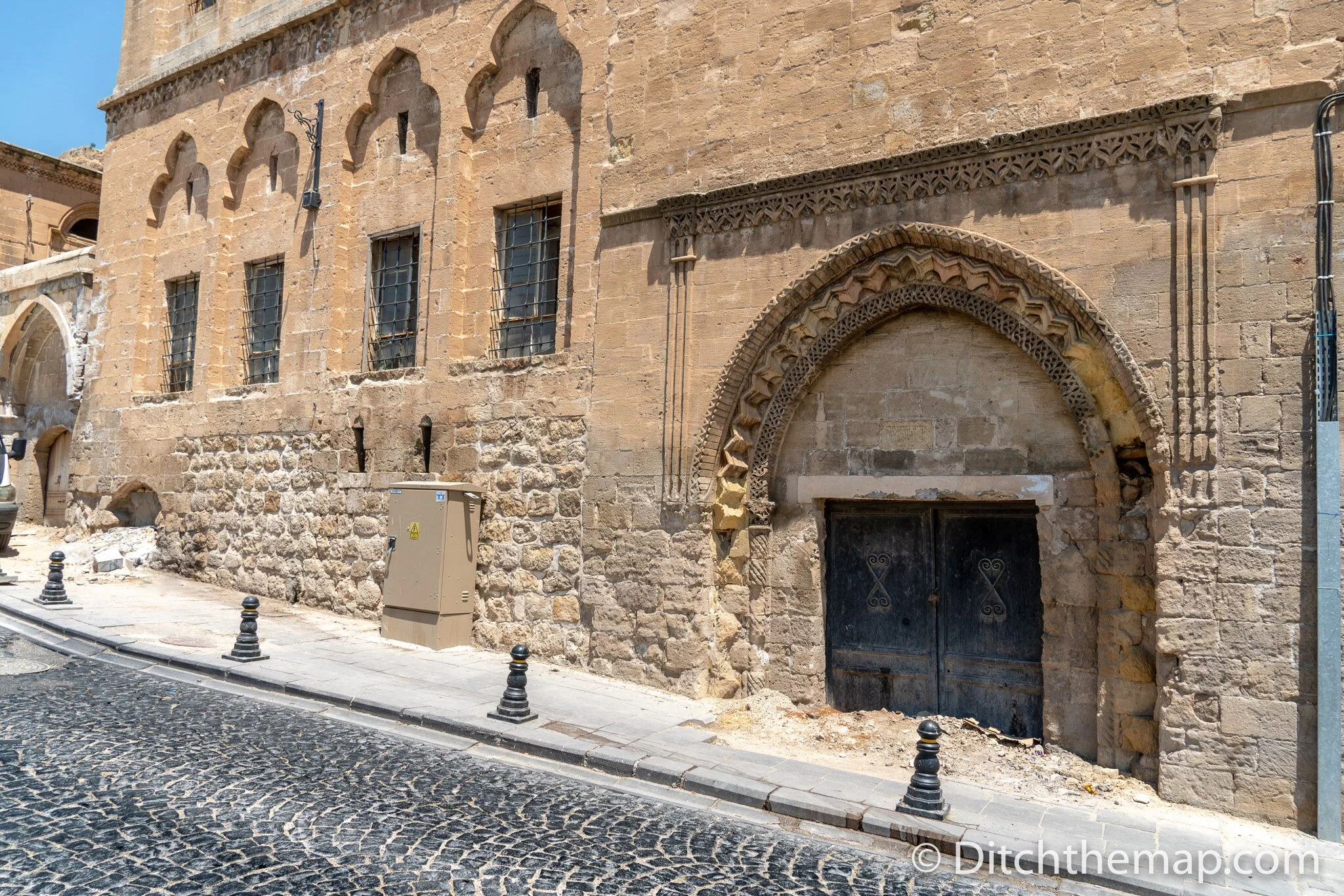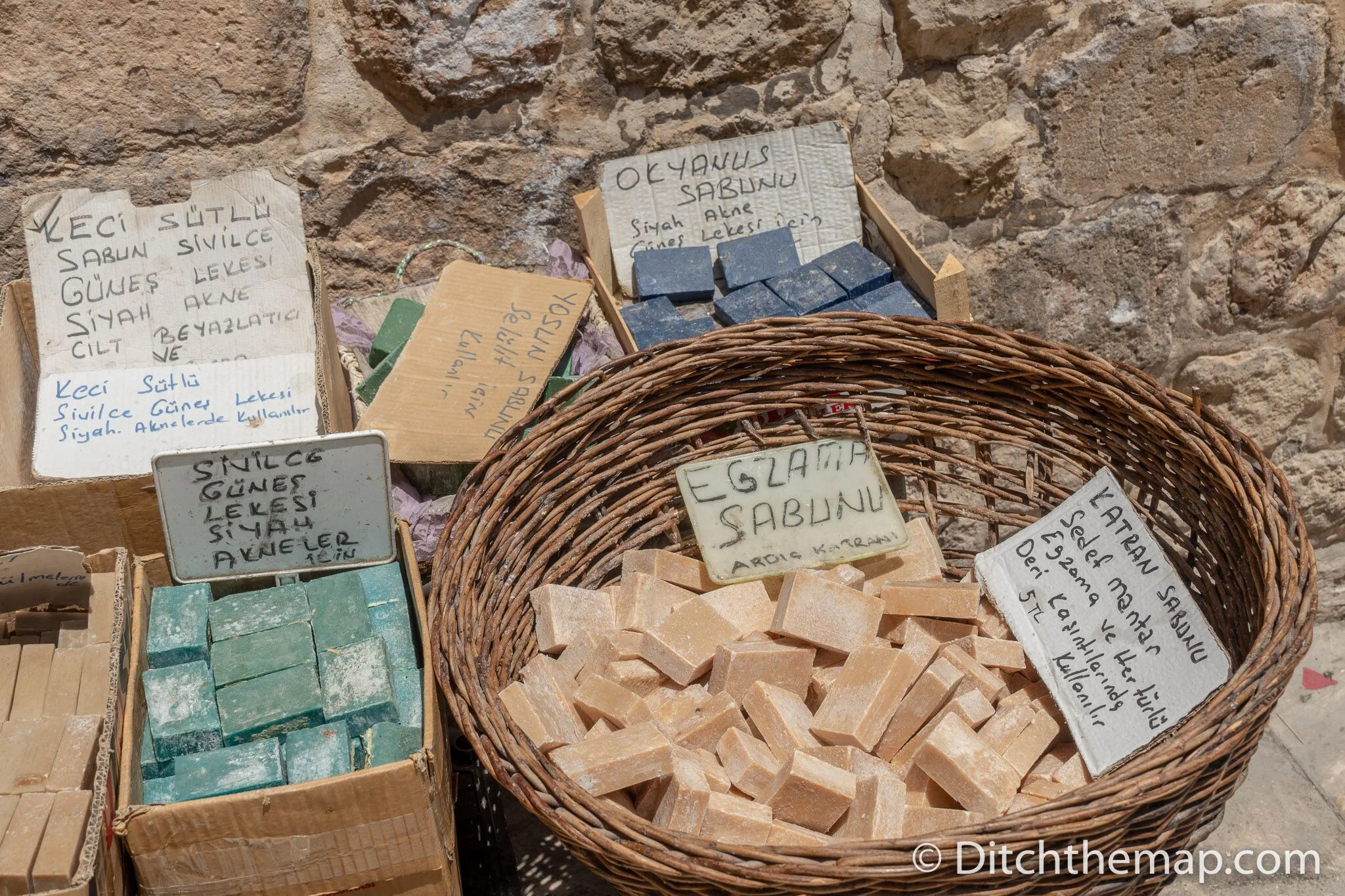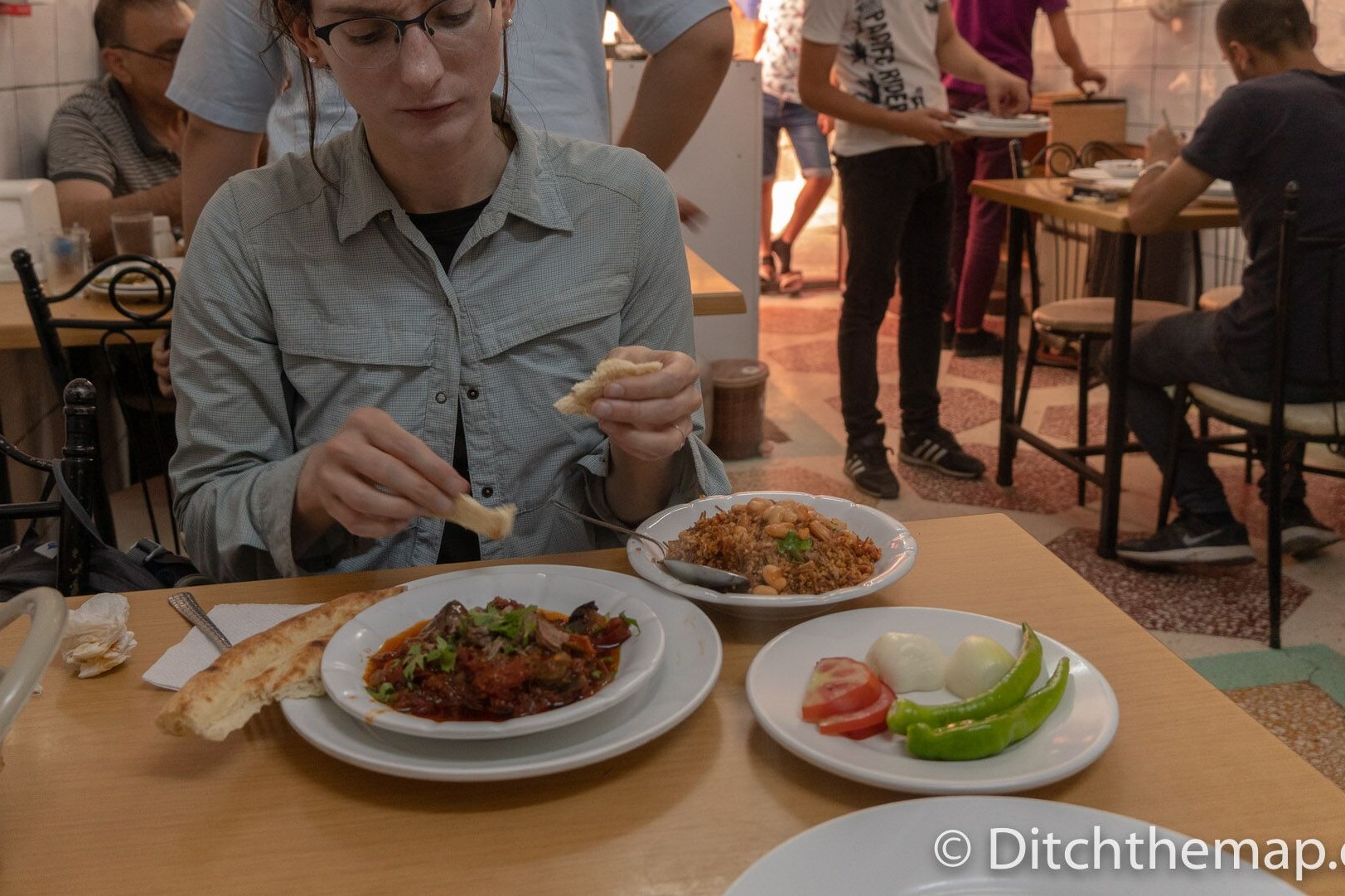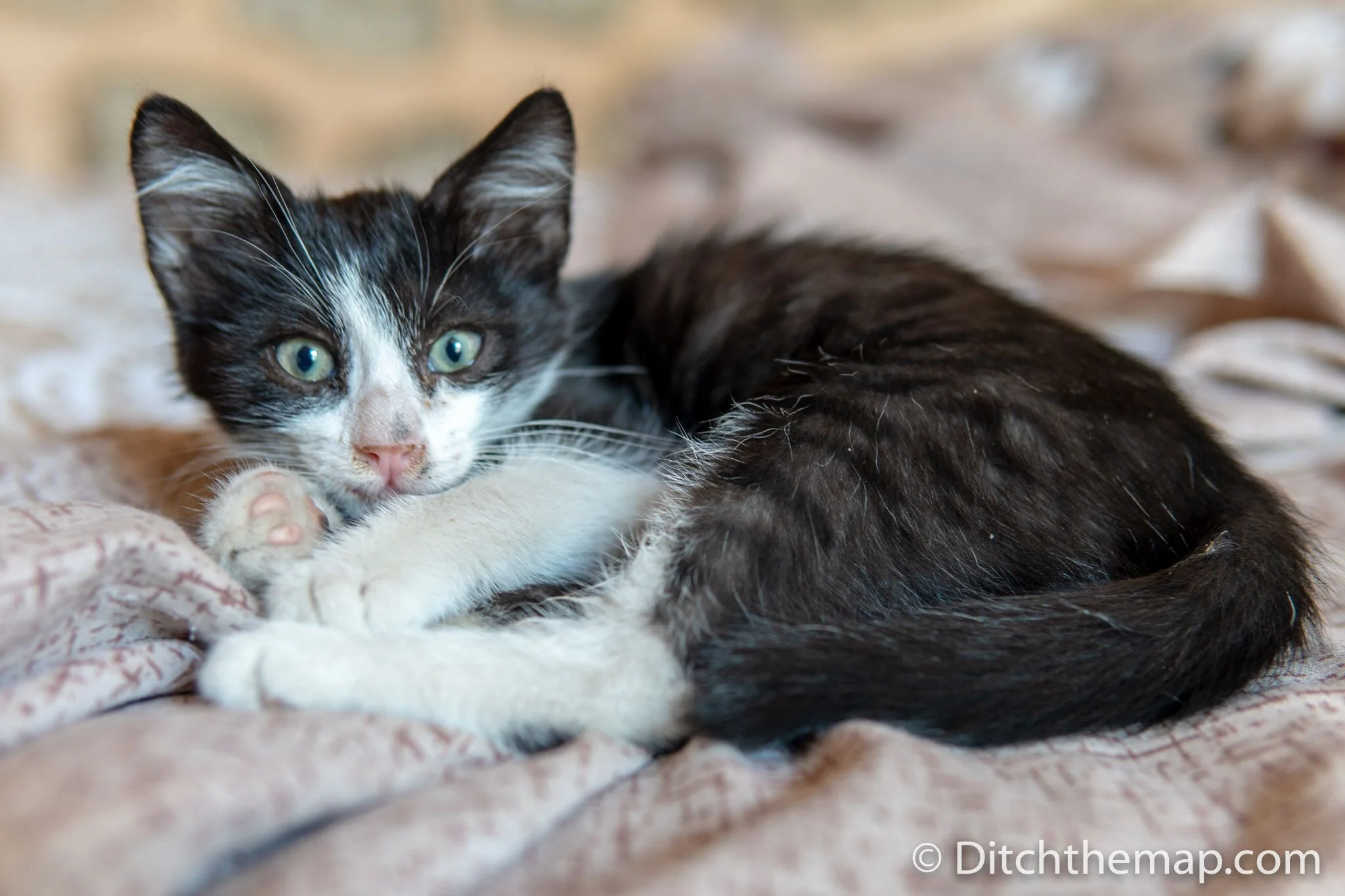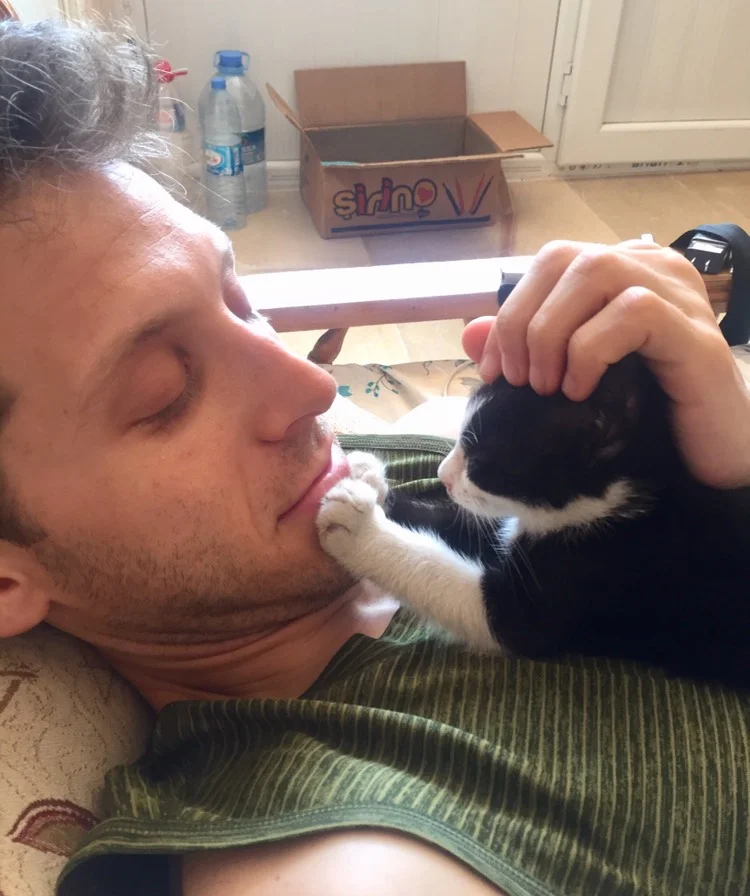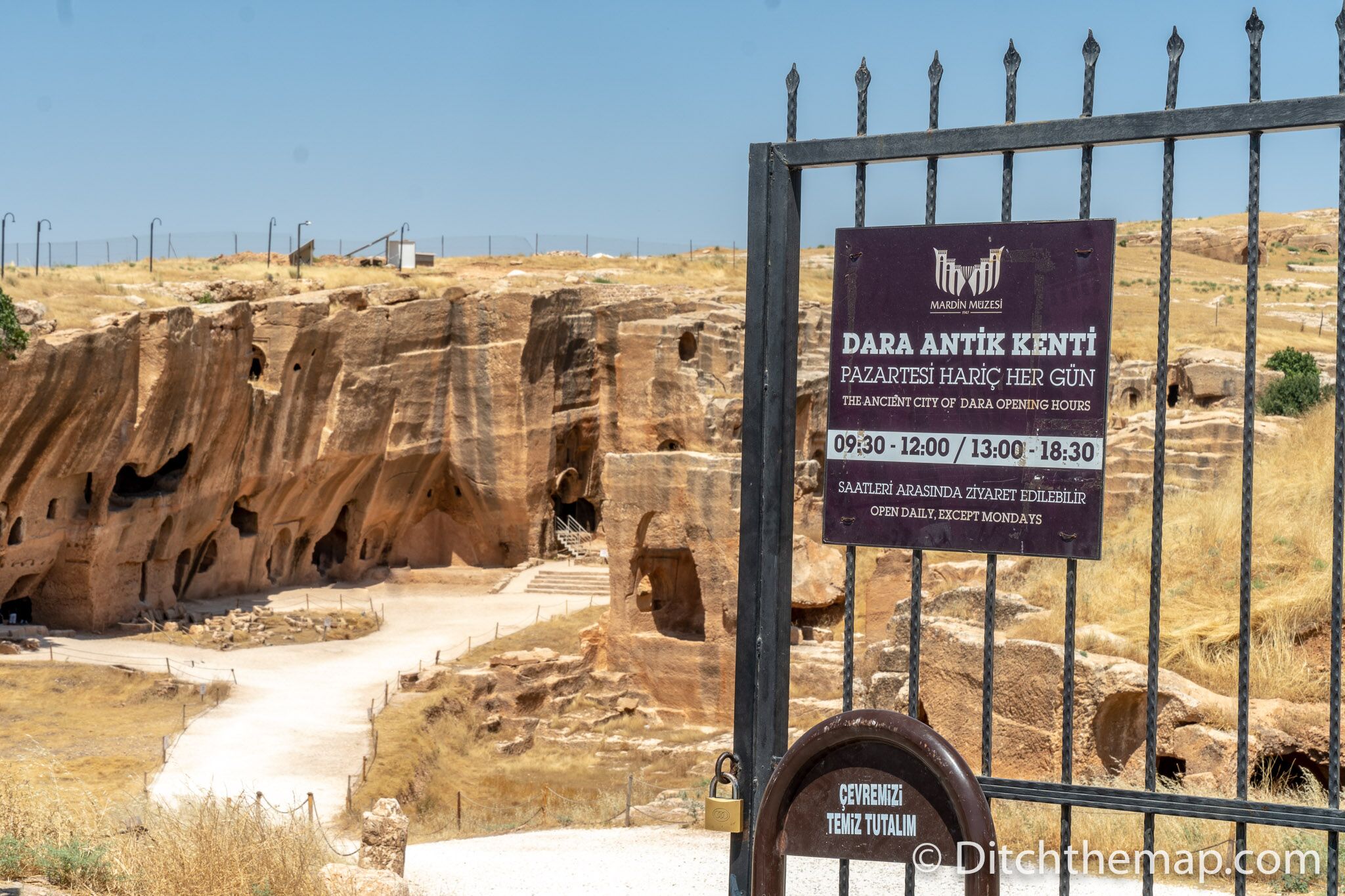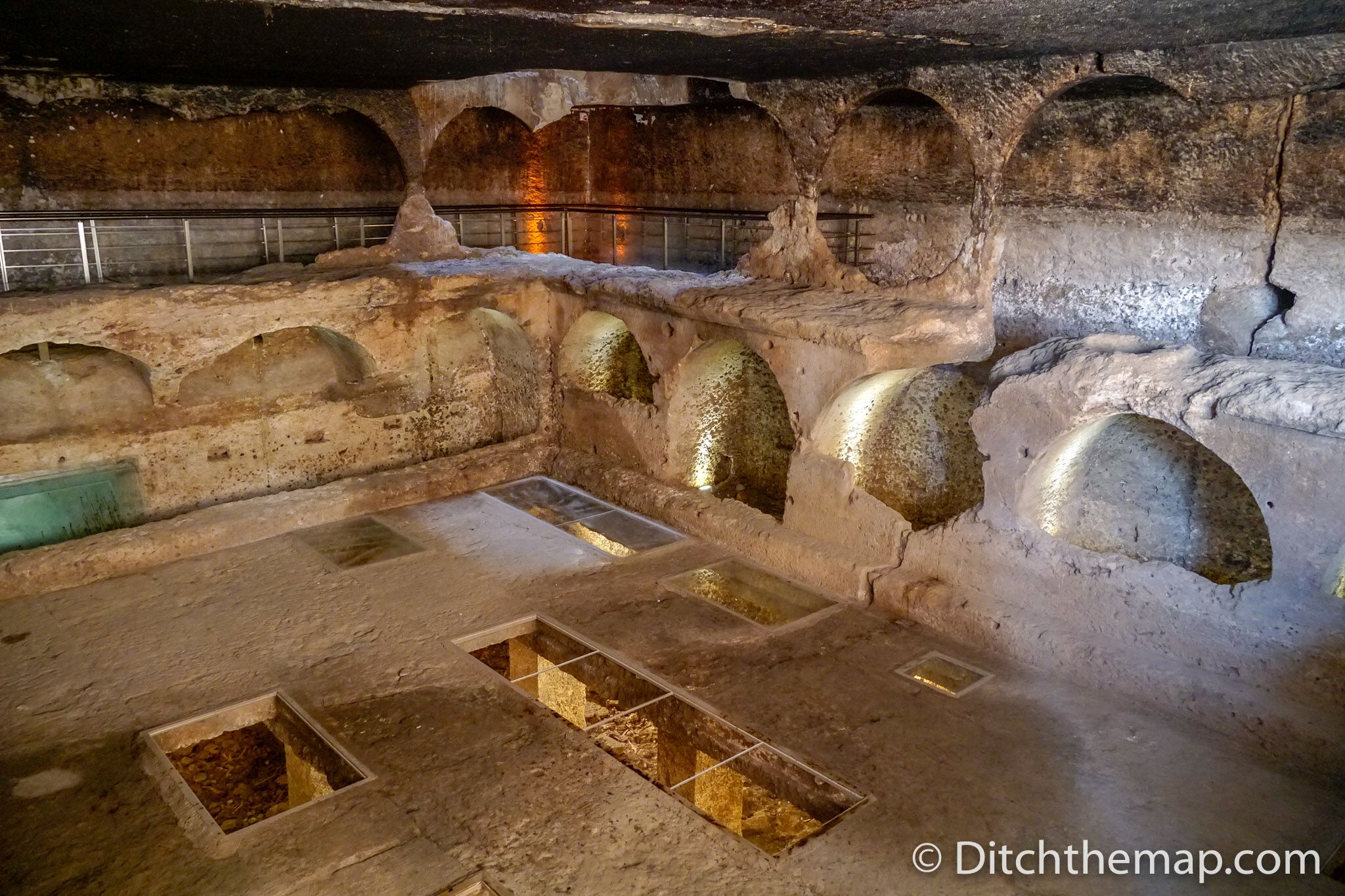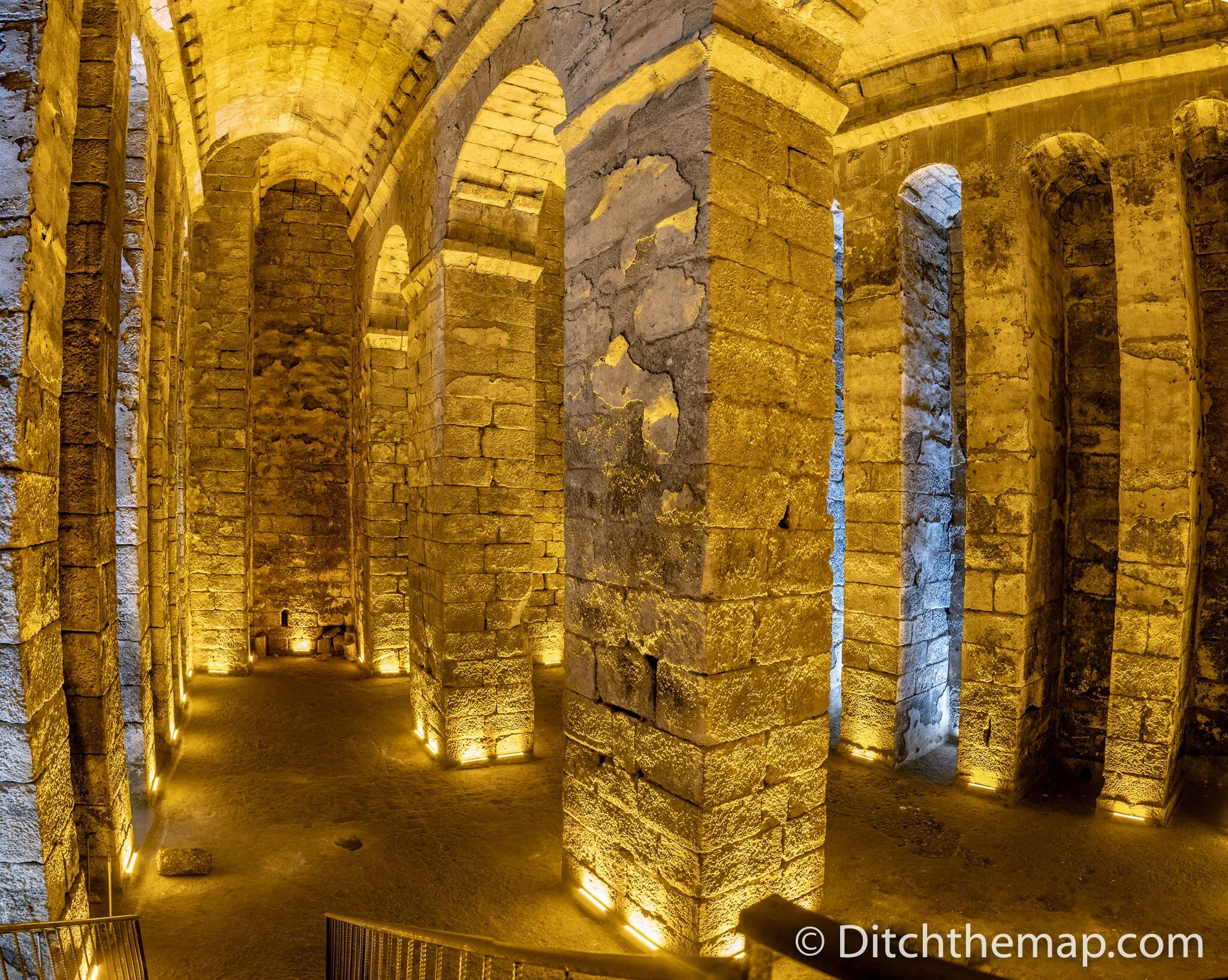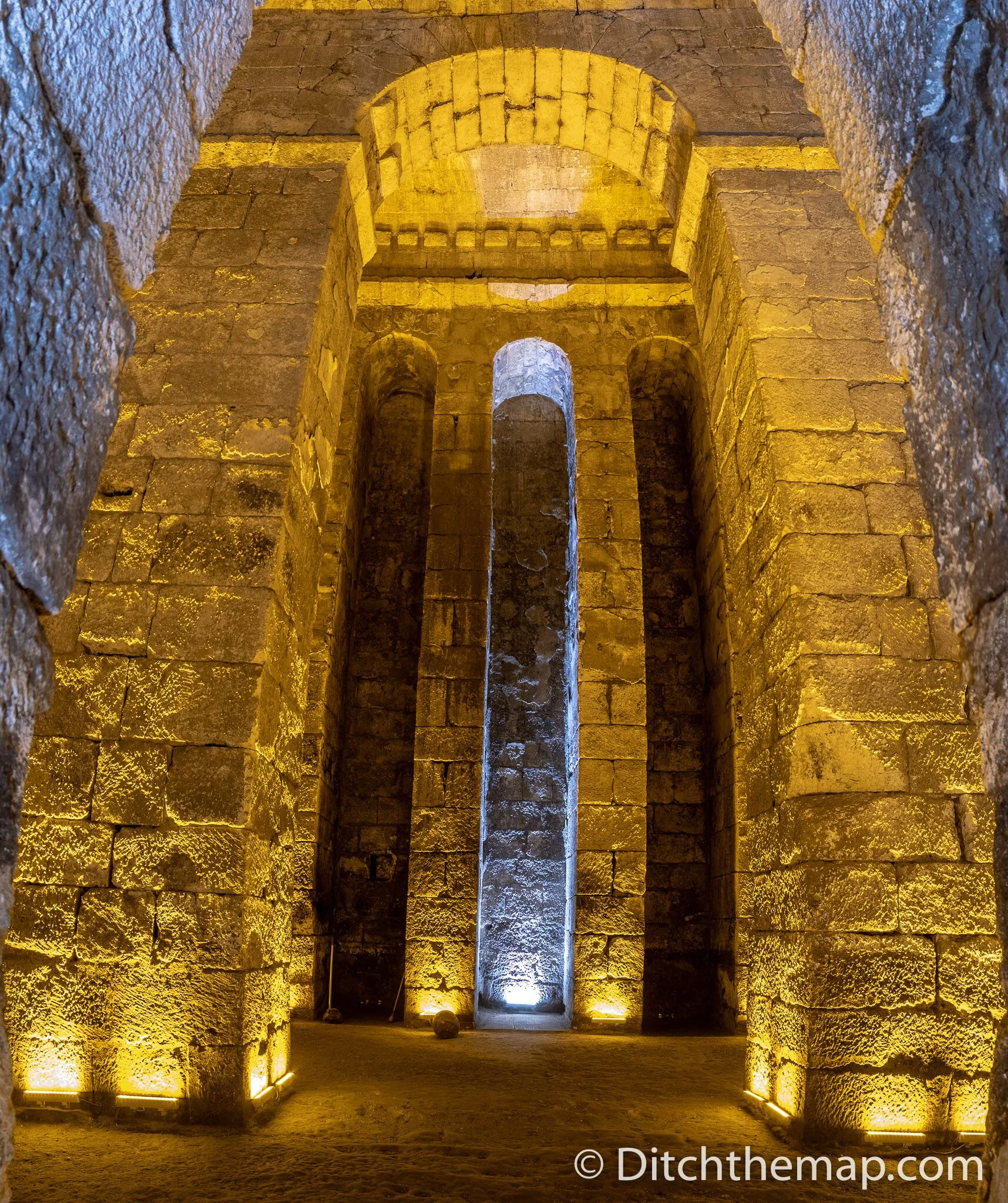Visiting Mardin - A Travel Guide to Southeastern Turkey's Most Beautiful City
/Arriving in Mardin, Turkey
Our drive through southeastern Turkey, from Van to Mardin, contained a security check point, which appears to be standard for overland travel in Turkey. Roadside police officers board the vehicle, collect Turkish identity cards from all passengers, run some kind of background check, and then, a few minutes later, return to the bus to distribute the cards. They weren’t interested in collecting our foreign passports, instead a quick glance sufficed.
Mardin (the red dot) is located in southeastern Turkey.
Mardin’s historical old city on the hill; photo from http://www.murat-karaca.com
On the minibus we felt every twist, turn and bump on the 6-hour journey to Mardin. As is customary, the bus made smoke-stops for nicotine depraved passengers (and driver) and one stop for lunch along the route. Pulling into the modern suburb of Yenişehir, our drop-off point just below Mardin, it was possible to see the castle of old city of Mardin sitting regally on the hilltop above. As the highest point on the surrounding Mesopotamian plains, Mardin’s old city dominates the landscape.
We exited the bus, relieved that the long uncomfortable ride was finished, and crossed the street to the dolmuş (minibus) stop where displaced Syrian children hawked water bottles. Moments later we caught a minibus and a pair of 20-something guys, looking at our bulky packs, generously forfeited their seats for us. Once in the old city, our final destination, we dropped our bags off in our airbnb – a traditional (refurbished) stone carved dwelling over 600-years-old (!) - before heading out to dinner. The apartment’s wall were so thick that the internal temperature was cool despite not having air conditioning.
Our stone AirBnb in Mardin, Turkey
Our First Tastes of Mardin: Trying Local Specialities
Before dinner we sat for a cup coffee, of which Mardin is know for a few local varieties. In additional to the standard cup of Turkish coffee we tried dibek coffee which is named for the dibek stone that was once used to grind the beans. The ground coffee is served sweet with a hint of cardamom. We also tried menengic coffee, but this is a misnomer. It isn’t actually coffee at all, it’s a hot drink made from roasted pistachio tree seeds that are ground into a paste and cooked with milk. Scott was a big fan on this un-caffeinated milky beverage.
A variety of coffee for sale on the street in Mardin, Turkey
Coffee for sale at a cafe in Mardin, Turkey
Drinking menengic (pistachio) coffee in Mardin, Turkey
We ate dinner on a rooftop that overlooked the vast plains onto Syria in the horizon. We sipped on Assyrian wine, which was traditionally homemade by a small community of Mardin based Christian-Orthodox Assyrians using local grapes. It was never consumed to get drunk, but rather to symbolize the blood of Jesus. Now production has gone commercial and you can find this sweet, unusual wine for sale in a few restaurants and many shops in Mardin.
As we dined, rambunctious children played in the narrow stone lined alleys below and minarets towered overhead. We observed fig saplings growing like weeds between cracks in the stone walls, stray cats slinking about, candy-covered almonds being distributed freely, and stores toting unwieldy piles of homemade soap. We watched the sun set as it saturated the stone houses in a warm golden hue. Only hours after arriving, Mardin had captivated us. In fact, we were so enamored by the city that we decided to extend our stay.
A view of Mardin, Turkey and the Mesopotamian plains
A minaret in Mardin, Turkey
Stone stairs and alley in Mardin, Turkey
Stone alleyway in Mardin, Turkey
Children pose for a photograph in Mardin, Turkey
A Background of Mardin, Turkey
Mardin is a city rich in history. For starters, it’s located in what was once known as Mesopotamia, the cradle of civilization. This region was once the homeland of the Syriacs, “an ancient people who trace their origin to the Akkadian Empire, established in Mesopotamia around 2200 BC. Syriac is a Semitic language directly related to the native tongue of Jesus Christ (https://en.wikivoyage.org/wiki/Mardin).” In the 5th century, Mardin was settled by Assyrian Christians, then Arabs. Later ownership passed from the Turks, to the Kurds, to the Mongols, to the Persians and then to the Ottoman Empire. Today a small group of Assyrian Christians remain in the Mardin area and some of their churches are still intact - you can even visit a few of these historical sites.
Is it Safe to Travel to Mardin?
Upon completing our own extensive research we’ve found that there have been no attacks directed towards tourists for years in the south of Turkey. The prior altercations have been between the Kurdish PKK militia and the Turkish government. If you look at the US State Department, however (as of July 2019), the US advises against travel to Turkey. They rate most of Turkey with a safety risk of 3 out of 4, which means: reconsider your travel plans. They give a blanket rating of 4, “Do Not Travel” to all areas near the Turkey/Iraq and Turkey/Syria border. However, we think this is unfounded. As an American, the sad truth is that your chances of being a victim of a mass shooting are more likely than experiencing a terrorist attack in Turkey. We felt very safe during our 3 months of travel around Turkey, which included visits to Van, Diyarbakir, Mardin, Urfa, Gaziantep, Antakya, Cappadocia, The Lycian Way, Selcuk, three towns along the Turquoise Coast, Istanbul, and Antalya. Not only did we not have a single issue regarding our health or safety, but we were also received with warmth from locals in all locations. If you haven’t read our post on the safety of backpacking through Turkey you can read the article here; Turkey Travel Safety 2019.
Overlooking the Mesopotamian plains in Mardin, Turkey
A boy plays in a Mosque in Mardin Turkey
Exploring Mardin’s Old City
We set out early in the morning to familiarize ourselves with Mardin’s Old City. Getting out as the city awakens is our favorite time of day - it’s still not too hot and energy emanates from the potential of a new day. With no plan in mind we meandered the alleys, too narrow for cars, but not for donkeys (which is consequently, how garbage is collected). The old city, which is not large, is easy enough to explore on foot - if you aren’t bothered by frequent uphill walking and stair climbing that is. The quiet back alleys felt like they were ours explore. Though domestic tourists visit Mardin they don’t venture far from the main street and international tourism hasn’t returned to full force since the Turkey-PKK conflict in the 90’s. We admired old ornate doorways, where the street level has risen over thousands of years to the midpoint of the door - a tangible reminder of just how old this city is.
Old doorway in Mardin, Turkey almost buried by the street.
We tried a variety of fresh breads displayed enticingly in front of bakeries, some fragrant with cinnamon and other spices, then meandered into a back alley bizarre where the dying craft of copper engraving is still showcased by a dwindling number of artisans. Homemade Mardin soap, a centuries old craft, is another locally produced item that can be found everywhere in Mardin. The soaps are special because of their natural, locally derived ingredients like olive oil and pistachio. There’s a soap to cure any skin malady - acne, eczema, wounds, hair loss - or so they say. Actually in need of soap, we purchased a bar for less than a dollar. (To find this price, get away from the main street to buy your soap.) The shop owner rang us up while a lit cigarette dangled from his lips. A shocking number of people smoke and there doesn’t seem to be any regulation as to where one can or cannot smoke.
Shopping alley in Mardin, Turkey
Homemade soap for sale on the street in Mardin, Turkey
Local breads on display in the streets of Mardin, Turkey
Winding down alleys further away from the main street we passed a man sitting on his stoop. He called after us; “where from?” and shortly after we were beckoned to join him. His daughter brought out a tray with coffee and through gesturing, inquired if we would like anything to eat. We were brought a tray of fruit and in addition the man extended his spoon and bowl to share his own breakfast of meat and bulgur with us. Using single words, we managed to communicate a bit. At the commotion outside his preteen grandson emerged and excitedly communicated with us using a cellphone and Google translate. He reassured us that we could ask for anything we wanted from them, and that we should ask “shamelessly.” Curious neighbors walked by and gave waves and smiles. The family pointed out a few Syrian people as they passed – a reminder of the influx of refugees and the war happening not too far away. With amusement they divulged that one of their neighbors has 46 children with his three wives.
At the end of our visit, the grandson communicated that “we are nice,” “ what we are doing is beautiful,” and that he “hopes we liked them.” With these parting words, we were sent us on our way to continue our exploration of the ancient city. Their kindness lingered with us for the duration of the day.
A local family in Mardin invite us to join them for coffee and food
After covering my head with a scarf, we entered The Grand Mosque. Inside the carpeted prayer hall we noticed two women craning their necks in order to place their face below a glass cabinet. They gestured to us and encouraged us to do the same thing. The cabinet contained a supposed hair from The Prophet Mohammad’s beard. We realized what they were doing - they were smelling the seam of cabinet door hoping for a whiff of the beard hair! Later, in a different mosque housing a ‘supposed footprint’ of Mohammed, a man opened the glass cabinet, swiped his hand down the footprint, then rubbed his hand onto his beard. It seems like interacting with religious items is full sensory experience here. People aren’t satisfied by only looking; they want to absorb it. (It also seems like doors, signs, and restrictions are headed as more of a “suggestion.”)
Courtyard of the Grand Mosque in Mardin, Turkey
On the outskirts of the bazaar we sat down for a cafeteria-style meal. I love these no-frills types of places where all of the options are on display. The atmosphere is simple, the service is prompt, and the food is typically delicious. The best part of eating a meal in Turkey is all of the additional plates of meze, condiments, garnish and/or veggies that come along with it free of charge. After finishing the meal, we headed toward the door and made sure to compliment the owner’s tasty food. In response he handed us a dough-covered fried ball of meat for the road. The Turkish people take great pleasure in feeding us!
Later, Scott got a haircut and shave. He can’t get enough of these barbers’ meticulous skills. He also spent over an hour being pampered at Emir Hamamı. This hammam (public bath house) has separate hours of entry for women and men. We’ve been looking for a bath house where males and females can attend together, and although it exists in some cities, it’s certainly not traditional and not found in Mardin. Fortunately, Scott was happy to assume the role of guinea pig and reported back his hammam experience.
Eating a delicious lunch in Mardin, Turkey
Scott gets a Turkish haircut and close shave in Mardin
Historically, hammams were public places for cleansing and relaxation. Scott felt like he stepped back in time when visiting the hammam, back to a time when access to a hot bath wasn’t readily available and one’s hygiene was entrusted to a burly professional. Scott’s hammam experience began in the sauna which he arrived in through a series of marble rooms. The temperature in the sauna climbed steadily from 131 degrees. At 155 degrees, Scott wondered if he’d been forgotten. Sweating, he exited and was lead to a large marble room where a hairy shirtless man, armed with a loofah, throughly scrubbed away layers upon layers of dead skin. Scott reports that the dead skin sloughed off in rolls. The scrubber-man then donned an oven mitt-like glove, lathered it with soap and scrubbed Scott’s entire body. Next he washed off the soap and gave Scott a brief but firm massage. One final rinse and Scott concluded his first trip to a hammam. He really enjoyed it. Now it’s my turn.
Turkish Hospitality - don’t turn down that cup of cay!
Locals took great interest in us and we had the pleasure of meeting quite a few during our stay in Mardin. Our english sparked attention wherever we went, and we were constantly met with friendly curiosity, the ever-present question of, “where are you from?” and invitations for tea. We met the persistent ice cream boy who demanded we stop by for a chat every time we passed his cart (he still texts Scott), we met a group of teenage boys who shared their liter of soda with us while attempting to speak English, and we met a young doctor through the couchsurfing network.
It was refreshing to hear the doctor’s progressive female perspective as we’ve mostly met men. In fact, in many of the Turkish cities we’ve visited it feels like a disproportionate amount of men are visible on the streets, sitting and chatting over cups of cay (tea) while smoking cigarettes. Over a glass of Assyrian wine, she provided some information about Turkey’s history and insights about the political climate. She was educated in the west of Turkey, but because Turkey is a democratic socialist country, she was assigned a year and a half of service in Mardin. Prior to working in Mardin she admitted to having some preconceived notions about the Kurdish people (who are densely populated in southeastern Turkey referred to as Kurdistan), a sentiment mirrored by some in western Turkey. However, after working in the southeast, near Turkish Kurdistan, and gaining exposure to this group of people she now has a much different opinion. Based on our experiences in Van and Diyabakir, we have found the Kurdish people to be absolutely delightful, open, and generous despite any existing tension.
Group of teenage boys share their soda with us and ask for a photo
On another occasion, as we played with a tiny kitten in an alleyway, an older man watched us from his balcony. Smiling down he called, “madam!” “milk!” We nodded in acknowledgment, not recognizing this exchange as an invitation. Moments later his 20-ish daughter entered the alley and invited us up for tea asking, “cay?” We followed her to the second floor of the building where her father (the older man), her mother, and a few other family members sat watching television. The TV was promptly turned off and everyone gave us a smile and friendly greeting. We were given ayran (a watery salted yogurt drink) and multiple glasses of cay. The older man communicated with a few single words of English but what he couldn’t communicate in words, he communicated with his smile and generosity. We sat through many moment of silence, wishing we could construct any semblance of a sentence in Turkish. Eventually we resorted to typing back and forth on his computer using google translate. We shared our plans for Mardin - he even offered to join us to see the sights. He gave us some suggestions, then showed us around his home. When it was time for us to leave visible dissapointment crossed his face. Even without a common language this family had taken it upon themselves to personally welcome us to their city and celebrate our presence in Mardin. We were blown away by their willingness to reach out to us and ensure that we felt accepted and comfortable in their hometown.
Men in Mardin ask for a photo with Scott
Invited in for tea in a local’s home in Mardin
Extending hospitality is in the Turkish people’s blood. It’s truly at the core of their beings and we’re happy to see that it’s not a dying trait. Hospitality is still very much intact in the younger generation as we observed in our 26-year-old neighbor. Our neighbor, also amused by our antics of caring for the abandoned kitten, invited us into his home for cay, tea. While pouring us tea and offering us cigarettes he used the few English words he knew. With no sense of rush or urgency, he embraced our company, asked us questions and shared information about himself. Currently he works as a solider. He asked us about our plans for Mardin and we admitted we were having difficulty figuring out transit to the archeological site of Dara - we couldn’t figure out the public bus and taxis had quoted us unfairly high prices. Immediately wanting to resolve our problem, he offered to go with us so a taxi would charge a fair local rate, and then he took it up a notch by calling a taxi-driver friend to inquire about securing a fair price. We accepted the price, as it was lower than the other offers we received. We visited Dara 30 minutes later accompanied by our neighbor; our own local ambassador.
I’ve been thinking about the displays of hospitality and the welcoming nature of the people we met in Mardin and I have some ideas where it may stem from - first and foremost, they are kind and sincere people, secondly, they take pride in their culture, thirdly I think it’s a culture that assumes less privacy - people sit outdoors inviting conversation with neighbors, extended family members come and go - it’s like the homes have a revolving door. Sometimes people sit in silence together, appreciating the company of others and not feeling a need to be entertaining but just cherishing the time spent together. I think the concept of privacy may be more of a western construct maybe in response to an overly stimulating life or the result of living in homes larger than our social species was meant for? For example, large suburban homes isolate individuals from neighbors and some houses are so large you can go hours without seeing family members. I also think that in the States we are plagued by a chronic need for “busy-ness” - if we’re busy, we’re productive and therefore '“useful”. We are a country that values productivity, perhaps sometimes at the expense of other virtues like the connection that can be built through shared idleness.
Men dance on the street in Old Town, Mardin
Now, this tiny little kitten that I’ve mentioned a few times really threw a wrench in our plans, but we couldn’t possibly stay mad at him and his cute lil’ face. We found him alone, stretched out on a stone staircase, with low-energy and a dry, crusty face. The little guy looked like he was in need of some hydration. (Might I add that temperatures reached 105 degrees during our stay in June!) We carried him a short distance to our courtyard where he frantically lapped up water and milk and put away a startling amount of the canned meat we’d just purchased for him. Over the next few days his energy reeved-up and he playfully raced around our rented apartment and courtyard like an adorable little doofus. We were growing quite fond of our pint-sized furry friend. But, were concerned by his lingering sneeze. We decided we couldn’t possibly return him to the streets and started a search for a new home for our little guy. Unfortunately, taking him with us wasn’t an option. So, Scott reached out to the local couchsurfing community for help.
Our kitten in Mardin, Turkey
Our kitten in Mardin, Turkey
Our kitten in Mardin, Turkey
Our plea was successful and the night before we were to leave Mardin we met with a guy living locally who had an interest in helping animals. We met for tea in the Old City and he told us about himself. He was born in Syria but now lived as a refugee in Turkey. Due to his refugee status he had difficulty finding a job, despite being highly educated in engineering and fluent in English (self-taught). He has not been able to return to Syria for six years. He has not seen his family, his parents, his brothers or sisters in person for six years. He feels a sense of hopelessness and a loss of freedom which is felt even more acutely as he’s less than 20 miles from his family but isn’t permitted to leave Mardin. He vocalized that citizenship is many other countries favors the wealthy and he feels defeated. He currently works as an English teacher. Lately he feels that the Turkish people are becoming increasingly less tolerant of Syrians in their country, commenting that some people are using hashtags on instagram that are hateful toward Syrians. In spite of this, he has a big heart. He put up with our escapade as we corralled the kitten into a box for transport and he continues to send photos and follows-up with us about the kitten. He took the kitten to the vet and paid for injections for an infection the kitten suffered from. We are so touched. He did not have to take on this responsibility on top of his own hardships. We are so thankful that our kitten found a loving home.
Visiting Mardin’s Historical Sites: Dara and Deyrul Zafaran Monastery
Entrance to Dara Archeological Site in Turkey
The Ancient City of Dara
The archeological site, Dara, is 30km south of Mardin and 7km from the Syrian border. The city was once a powerful fortress for the Romans during the 6th century. Today there are two major location to explore: the necropolis and the water cistern. We arrive at the necropolis by taxi and spent about 40 minutes walking the grounds. It’s possible to see carved cave tombs and an expansive gallery grave where hundreds of bodies were buried in a massive grave. Peering into the tomb its possible to see countless bone remains beneath a glass floor. Dara’s necropolis served as a cemetery for almost 1,500 years.
Tombs carved into rock in Dara, Turkey
Tombs carved into rock in Dara, Turkey
Tombs carved into rock in Dara, Turkey
Rock tombs in Dara, Turkey
Gallery grave in Dara, Turkey
Bones below the glass in the gallery grave Dara, Turkey
A few minutes by car took us to the impressive Dara water cistern, which was accidentally discovered by a farmer in the area. Descending into the cistern, the temperature drops and it’s possible to image the volume of water once contained between the ornate stone arches. Entrance to both sites is free. We encountered only a few tourists at each site.
Water cistern in Dara, Turkey
Water cistern in Dara, Turkey
Deyrul Zafaran Monastery (Mor Hananyo Monastery)
The still active Deyrul Zafaran Monastery is located 6km outside of Mardin. Built for the Assyrian Christians in 493AD, this monastery is still one of the most important religious centers for the Assyrian Church. It was built on what was originally a sun temple and later used a castle by the Romans. A small area is open to the public for a fee. There is no public transit to the monastery, so a taxi is your best option.
Deyrul Zafaran Monastery near Mardin, Turkey
Mardin City Museum
Also worth a mention is the lovely Mardin City Museum, it’s small but loaded with interesting historical and cultural information about Mardin with english translations.
At a Glance - Mardin’s Highlights:
What to do in Mardin: shop in the bazaar, stroll through the alleyways of the old city, visit a hamam, get acquainted with the friendly locals
What to buy in Mardin: traditional Mardin soap and Assyrian wine
What to eat and drink in Mardin: sip on the local coffee varieties and sit for dinner at a roof top restaurant for some unique Mardin cuisine
What to see in Mardin: Dara Necropolis, Dara Cistern, Mardin City Museum, and Deyrul Zafaran Monastery
Pin this article and read at a later time



